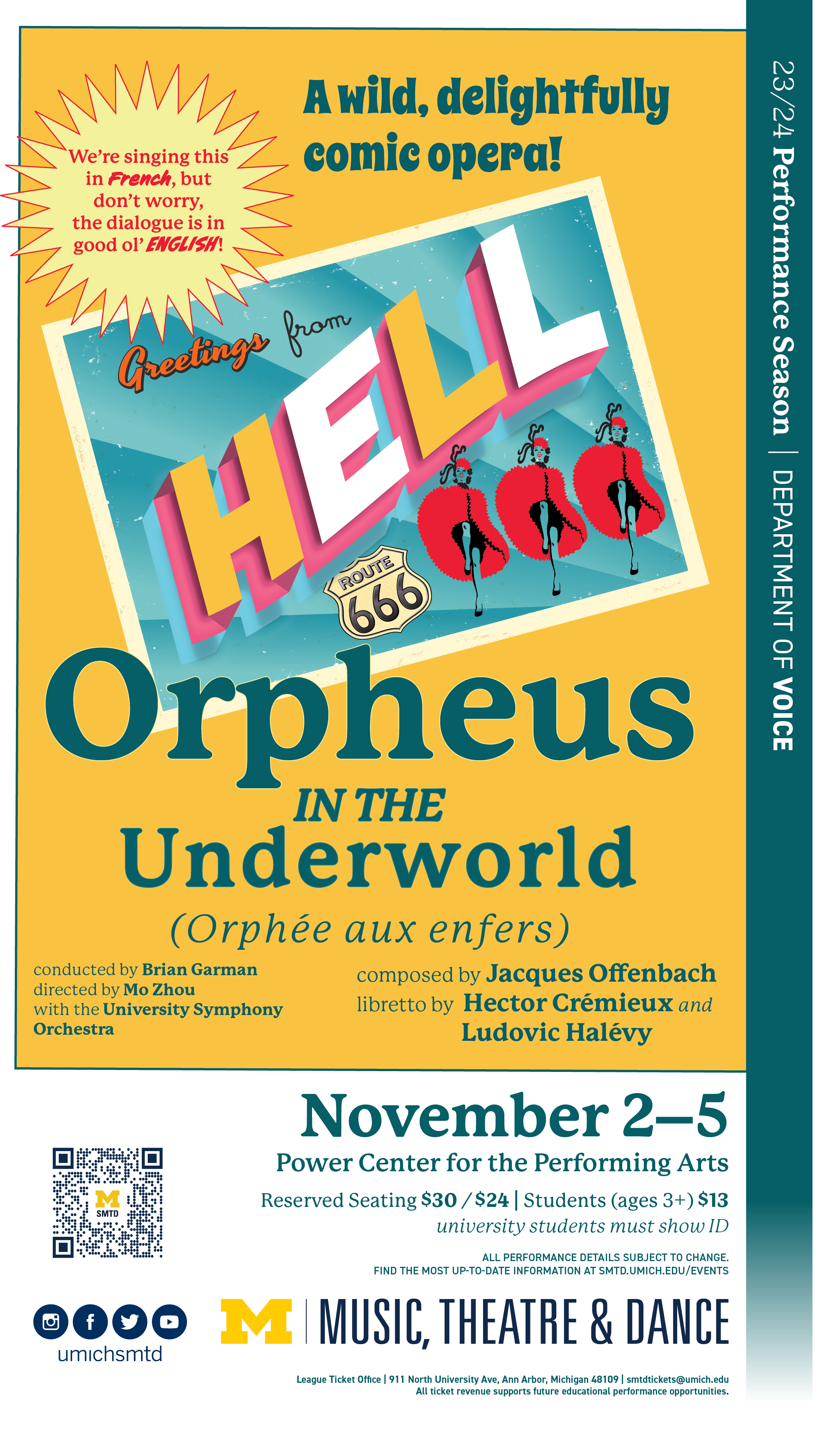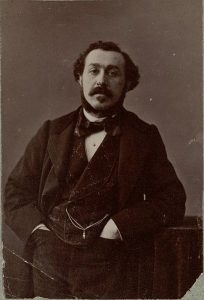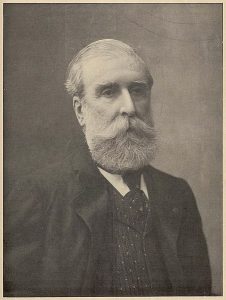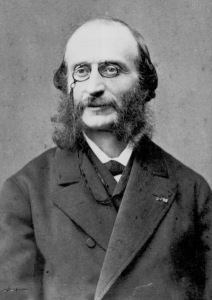Performance Programs

Creative Team
Conductor
Brian Garman+
Director
Mo Zhou
Scenic Designer
Kevin Judge
Costume Designer
Sarah M Oliver
Lighting Designer
Marie Yokoyama+
Hair and Makeup Designer
Brittney Crinson
Répétiteurs
Peter Smith‡, Daniel Weber‡
Diction Coach
Timothy Cheek
Choreographer
Bohuslava (Slávka) Jelínková
Resident Intimacy Choreographer and Cultural Consultant
Raja Benz
Dramaturg
Karin Waidley
Assistant Conductor
Luca Antonucci‡
Chorus Director
Sydney Mukasa‡
Production Stage Manager
Abby Schneck+
Calling Stage Manager
Esmay Pricejones‡
‡SMTD Student
+SMTD Guest Artist
Cast
Thursday/Saturday
Aristeus/Pluto
Spencer VanDellen
Jupiter
Amante Pando Girard
Eurydice
Goitsemang Lehobye
Public Opinion
Daiyao Zhong
Orpheus
Alexander Nick
Friday/Sunday
Aristeus/Pluto
Tyrese Byrd
Jupiter
Jack Morin
Eurydice
Sohyun Cho
Public Opinion
Qirong Liang
Orpheus
Carson Arcuri
All Performances
Juno
Hannah Yan
Mercury
Ian Pathak
Diana
Pelagia Pamel
Venus
Yongxin Zhou
Cupid
Veronica Koz
Minerva
Maggie Reed
John Styx
Loren Reash-Henz
Mars
Thomas Long
Bacchus/Elvis
Benjamin Isyk
Chorus
Amelie Besch*, Jake Bullard, Kyleigh Burtley*, Ian Danaher, Mira Grayton*, Jamiyah Hudson*, Allison Lange*, Molly Levin*, Isaiah Liggins, Brendan Lockhart, Mark Pettaway III, Amber Sosa*, Brooke Studebaker*
* indicates Can-Can Dancer
Orchestra
Conductor
Brian Garman
Assistant Conductor
Luca Antonucci^
Violin I
Andrew Choi**, Erin Cho, Angela Lee, Kirsten Lee, Matt Xu, Cara Wunder
Violin II
Cameron Jeppson*, Jordan Bartel, Zoe Fong, Liana Fonseca,
Ian Stripling Jenson, Anna Linder
Viola
Margot Cunningham*, Mateo Calderon,
Alondra Damian-Noyola,
Diego Mieres
Cello
Maxwell Remmer*,
Nathaniel Hagan,
Cal Walrath
Double Bass
Samuel Stover*,
James Gold
Flute
Abi Middaugh,
Alexis Phinney
Oboe
Selina Langfeldt
Clarinet
Jacqueline Groves,
Nathan Rodriquez
Bassoon
Eduardo Martinez
Trumpet
Gavin Ard
Horn
Caroline Finamore,
Zachariah Reed
Bass Trombone
Chris Tam
Timpani
David Wang
Percussion
Rachel Richards
^The Sunday, November 5 performance was conducted by
assistant conductor Luca Antonucci.
**Concertmaster
*Principal
Assistants to the Creative Team
Assistant Director
Rosanne Lee
Assistant Scenic Designer
Audrey Tieman
Assistant Lighting Designer
Sydney Geysbeek
Assistant Costume Designer
Cole Carrico
Assistant Dramaturgs
Abigail Labbé, Alexander Nick
Production Crew
1st ASMs Esther Hwang, Maya Liu
2nd ASMs Evan Kiel, Fabian Rihl, and Isabelle Hopf
2nd ASM (Observer) Lleyton Allen
Assistant Master Electrician Ethan Hoffman
Assistant Properties Manager Dallas Fadul
Guest Scenic Artist Violet Flores
Sound Engineer Al Hurschman
Shop Crews
Theatrical Lighting Shira Baker, Abi Farnsworth, Sydney Geysbeek, Ethan Hoffman, Elianna Kruskal, Brandon Malin, Megan Mondek, Christian Mulville, Gabriela Ribeiro Znamensky, Kathleen Stanton-Sharpless, William Webster, Miles Zoellick
Painting Gilayah McIntosh, Bella Rowlison, Martha Sprout, Seri Stewart, Lauren Streng, Ellie Vice, Amber Walters, Angela Wu & Theatre 250/252/262 students
Props Eliza Anker, Danielle Bekas, Andy Blatt, Madysen Casey, Aquila Ewald, Dallas Fadul, Audrey Hollenbaugh, Lucy Knas, Teresa Morales, Charlotte Stallings, Audrey Tieman & Theatre 250/252 students
Scenery Marium Asghar, Juliet Bornholdt, Andy Blatt, Anna Forberg, Miles Hionis, Hannah Kryzhan, Michael Russell, Sophia Severance, Lauren Streng, Eliza Vassalo & Theatre 250/252/262 students
Costumes Maya Liu, Esmay Pricejones, Kaytlin Sanchez, Ellie Van Engen & Theatre 250/252/262 students
Production Office Briana Barker, Justin Comini, Estie Hwang
Running Crew
Light Board Operator Shelby Holloway
Follow Spot Operators Tate Zeleznik, Morgan Gomes
Supertitles Operator Wes Mason
Deck Crew Chief/Electrician William Webster
Scenery Deck Crew Diamond Na, Hannah Kryzhan
Props Deck Crew Chloe (Seoyeon) Yoo^, Banks Krause, Emily Hauer
Wardrobe Crew Mila McCoy^, Cristina Benn, Aspen Kinomoto, Emily Weddle
Hair and Makeup Crew Javier Torres, Cora Vanfaasen
^=Crew Head
Design & Production Faculty Advisors
Head of Design & Production Christianne Myers
Stage Management Nancy Uffner
Scenic Design Jungah Han, Kevin Judge
Costume Design Christianne Myers, Sarah M. Oliver
Lighting Design Jess Fialko
Sound Design Henry Reynolds
Staff Mentors
Brittany Crinson, Heather Hunter, Chad Hain, Beth Sandemaier
Department of Voice
Chair
Scott Piper
Opera Faculty
Timothy Cheek, Kirk Severtson, Matthew Thompson, Mo Zhou
Voice Faculty
Freda Herseth, Stephen Lusmann, Caitlin Lynch, Amanda Majeski,
Rose Mannino, Stanford Olsen,
Scott Piper, George Shirley,
Louise Toppin, Daniel Washington, Stephen West
Associated Faculty
Antonio Cuyler, Caroline Helton
Distinguished Visiting Artist
Thomas Hampson
Professors Emeriti
Willis Patterson, Carmen Pelton, George Shirley
University Productions Administrative Staff
Executive Director
Jeffrey Kuras
Sr Administrative Specialist
Christine Eccleston
Sr Administrative Assistant
Nathan Carrillo
Information Systems Manager
Henry Reynolds
Facilities Manager
Shannon Rice
Performance Halls
House Manager
Kelley Krahn
Lead Backstage Operations Manager
Dane Racicot
Senior Backstage Operations Manager
David Pickell
Backstage Operations Managers
Tiff Crutchfield, Alex Gay, Yvette Kashmer, Robbie Kozub
University Productions Production Staff
Production Manager
Paul Hunter
Assistant Production Manager
Michelle Williams-Elias
Technical Director (Walgreen)
Richard W. Lindsay Jr.
Theatrical Scenery Manager
Chad Hain
Lead Scenic Carpenter
Devin Miller
Scenic Carpenter
Heather Udowitz
Charge Scenic Artist
Beth Sandmaier
Associate Theatrical Paint Manager
Madison Stinemetz
Theatrical Properties Manager
Patrick A. Drone
Associate Theatrical Properties Manager
Danielle Keys
Senior Properties Artisan
Dan Erickson
Visiting Theatrical Hair and Makeup Manager
Brittany Crinson
Theatrical Lighting Manager
Heather Hunter
Associate Theatrical Lighting Manager
Jorrey Calvo
Sound Designer/Engineer
Henry Reynolds
Costume Shop Manager
Laura Brinker
Assistant Costume Shop Manager
Leslie Ann Smith
Lead Cutter/Draper
Tj Williamson
Cutter/Drapers
Seth Gilbert, Sarah Havens
Stitcher
Rene Plante
Theatrical Stitcher
Marcia Grace
Lead Costume Crafts Artisan
Elizabeth Gunderson
Costume Stock Manager
Theresa Hartman
Wardrobe Manager
Rossella Human
Theatrical Properties Stock and Tech Coordinator
Katherine Kreutz
Resources
Act I – 1st Tableau: In late 1950s suburban America, on the cusp of the 1960 presidential election, the uninspired musician Orpheus is ensnared in a lackluster marriage with his wife, Eurydice. Her affections have strayed to Aristée, a charming shepherd and honey merchant who is secretly Pluto, the Mafia King of the Underworld. Pluto engineers Eurydice’s demise with a venomous serpent, leaving both Eurydice and Orpheus strangely content. Public Opinion urges Orpheus to save his wife.
Act I – 2nd Tableau: At an opulent waterfront estate in Cape Cod, Massachusetts, following a night of debauched festivities, the elite godlike families are abruptly awakened by Diana. She bemoans Actaeon’s sudden disappearance, and Jupiter reveals he transformed Actaeon into a stag to safeguard her reputation. Mercury reports Pluto’s return from the Underworld with an enigmatic woman. The gods revolt against Jupiter’s dreary rule and expose his salacious liaisons. The arrival of Orpheus and Public Opinion compels the privileged crowd to comply, and they embark on a journey to Las Vegas.
INTERMISSION
Act II – 3rd Tableau: In a clandestine boudoir at the Sands Hotel and Casino in Las Vegas, Eurydice, held captive by Pluto, is tended to by her inebriated butler, John Styx, who laments his lost kingship. Jupiter, disguised as a golden fly, rendezvous with Eurydice and discloses his desires. Pluto chastises John Styx as they prepare for a party.
Act II – 4th Tableau: Within the VIP lounge of the Sands Hotel and Casino, a colossal party ensues as the gods arrive in Las Vegas. The unexpected appearance of Elvis Presley disrupts Jupiter’s plan. Amid a frenzied minuet and a spirited can-can, Pluto thwarts Jupiter’s design. As Orpheus and Public Opinion attempt to retrieve Eurydice, a lightning bolt from Jupiter forces Orpheus to look back, causing Eurydice to vanish. Jupiter declares his allegiance to the Vegas Scene, Public Opinion is displeased, Pluto abandons Eurydice, Orpheus gains freedom, and Eurydice discovers a new spark with Elvis, leading to a joyful conclusion.
The performers in this production were students in the Department of Voice and the University Symphony Orchestra. The designers for this production were students, faculty, and/or guests of SMTD. Scenery, costumes, properties, sound, and lighting were realized by the students and staff of University Productions, the producing unit of the SMTD. Thank you for supporting our educational mission.
Licensing
ORPHEE AUX ENFERS (the OEK CRITICAL EDITION: 1858 VERSION) is used by arrangement with Bote & Bock Berlin and Boosey & Hawkes, publisher and copyright owner.
Additional excerpts from ORPHEE AUX ENFERS by Jacques Offenbach (pub. HEUGEL) is presented under license from G. Schirmer Inc. and Associated Music Publishers, copyright owners.
English translation for ORPHEE AUX ENFERS (JEREMY SAMS TRANSLATION) is used by arrangement with Boosey & Hawkes, Inc., Agent in the USA for Josef Weinberger, Ltd., London, publisher and copyright owner.
 Hector Crеmieux (Libretto, 1828–1892) was a French dramatist whose work was heavily inspired by the politics of his day. During the revolution of February 1848, he secured a commission as lieutenant of the Garde Mobile. The turbulent French political landscape he grew up around inspired Crémieux to adapt the history of [Giovanni Luigi] Fiesco, from the German of Friedrich Schiller, for the French stage. The emperor, solicitous to bestow political patronage upon those who had been daring enough to give him support in the risky affair of December 2, rewarded Crémieux in 1852 with a clerkship in the Ministry of State. This patronage enabled him to enter upon a literary career and to exploit the financial possibilities of the Parisian stage of the second empire. Crémieux had a long and illustrious theatrical career, but to this day his most famous work remains Orpheus in the Underworld. Sadly, Crémieux committed suicide in 1892.
Hector Crеmieux (Libretto, 1828–1892) was a French dramatist whose work was heavily inspired by the politics of his day. During the revolution of February 1848, he secured a commission as lieutenant of the Garde Mobile. The turbulent French political landscape he grew up around inspired Crémieux to adapt the history of [Giovanni Luigi] Fiesco, from the German of Friedrich Schiller, for the French stage. The emperor, solicitous to bestow political patronage upon those who had been daring enough to give him support in the risky affair of December 2, rewarded Crémieux in 1852 with a clerkship in the Ministry of State. This patronage enabled him to enter upon a literary career and to exploit the financial possibilities of the Parisian stage of the second empire. Crémieux had a long and illustrious theatrical career, but to this day his most famous work remains Orpheus in the Underworld. Sadly, Crémieux committed suicide in 1892.
—Bio excerpted from Jewish Encyclopedia
 Ludovic Halévy (Libretto, 1834–1908) was born in Paris. His uncle, Fromental Halévy, was a noted composer of opera; hence the double and early connection of Ludovic Halévy with the Parisian stage. In 1855, he became acquainted with the musician Offenbach. His first work was produced under the pseudonym of Jules Servières. The name of Ludovic Halévy appeared for the first time on the bills on January 1, 1856. Soon afterwards, the unprecedented run of Orpheus in the Underworld, written in collaboration with Hector Crémieux, made his name famous. Late in life, Halévy remained an assiduous frequenter of the Academy, the Conservatoire, the Comédie Française, and the Society of Dramatic Authors, but, when he died in Paris on 7 May 1908, he had produced practically nothing new for many years.
Ludovic Halévy (Libretto, 1834–1908) was born in Paris. His uncle, Fromental Halévy, was a noted composer of opera; hence the double and early connection of Ludovic Halévy with the Parisian stage. In 1855, he became acquainted with the musician Offenbach. His first work was produced under the pseudonym of Jules Servières. The name of Ludovic Halévy appeared for the first time on the bills on January 1, 1856. Soon afterwards, the unprecedented run of Orpheus in the Underworld, written in collaboration with Hector Crémieux, made his name famous. Late in life, Halévy remained an assiduous frequenter of the Academy, the Conservatoire, the Comédie Française, and the Society of Dramatic Authors, but, when he died in Paris on 7 May 1908, he had produced practically nothing new for many years.
—Bio excerpted from the Opera San Jose
 Jacques Offenbach (Composer, 1819–1880) is a French composer of German origins (he became a naturalized French citizen in 1860) who wrote some of the most attractive and melodious music for the stage during the middle years of the nineteenth century. While his final work, the opéra fantastique The Tales of Hoffmann, is one of the most significant French operas of the nineteenth century, Offenbach’s main achievement is in the field of operetta, in which he excelled, producing almost 100 examples. Several operettas continue to keep a place in the repertory, notably Orpheus in the Underworld and La belle Hélène, which, though based on ancient myth, mercilessly satirize Napoleon III’s Second Empire and Parisian society of the day.
Jacques Offenbach (Composer, 1819–1880) is a French composer of German origins (he became a naturalized French citizen in 1860) who wrote some of the most attractive and melodious music for the stage during the middle years of the nineteenth century. While his final work, the opéra fantastique The Tales of Hoffmann, is one of the most significant French operas of the nineteenth century, Offenbach’s main achievement is in the field of operetta, in which he excelled, producing almost 100 examples. Several operettas continue to keep a place in the repertory, notably Orpheus in the Underworld and La belle Hélène, which, though based on ancient myth, mercilessly satirize Napoleon III’s Second Empire and Parisian society of the day.
—Excerpted from the English National Opera
“In short, the operetta made a mock of all the glamour that surrounded the apparatus of power.” (Kracauer 207)
Given that it is an adaptation of a classic Greek myth, Offenbach naturally baked elements of the Greek tragedies into this opera, including the chorus that acted as a collective voice to provide insight and emotional reactions to the audience for the action onstage. Hailing from the Greek dythramb, a choral hymn sung about gods and heroes, these odes served as a rhythmic bridge of social commentary between the performers and the audience. Offenbach took a different approach, however, with his version of the chorus; instead of a collective, it is a singular character, specifically named Public Opinion. Myths explore themes of moral and ethical dilemmas. Between the hubris and hamartia of the tragic heroes and heroines and gods manipulating mortal lives, these chanted or sung conversations were central to understanding the mythology. In Jacques Offenbach’s Orphée aux Enfers, Public Opinion acts as the voice of reason or the conscience that frames, moderates, and influences the action – or at least it serves as a voice that attempts to rein in the excess represented by Orpheus’ languid dismissal of his wife’s betrayal and exposes the hedonistic and mercurial nature of the ruling Olympus elite. The choice to personify this conscience as a singular individual rising up against patriarchal order in such a satirical landscape plays into the hilarity of the peeling back the glamour (and gender identity) of those in power. We may see one person, but within their voice is a critique of societal convention or perhaps a warning to power that strength lies in the unexpected.
Because Offenbach carved liberation through flouting the conventional opera of his time, in this opera bouffe, he chose to portray Public Opinion as a mezzo-soprano and as a female-identifying individual. He gave the voice of the collective Greek chorus, originally consisting of only male actors, to someone who historically was not given a voice. In a similar vein, this opera satirizes the institution of marriage, portraying it as a source of unhappiness and an obvious path for infidelity. Characters such as Venus and Eurydice actively pursue romantic fulfillment outside of their “stations.” This emphasis on female agency aligns with emerging feminist ideas of the time, as well as Offenbach’s desire to overturn entrenched social orders, as the libretto narrates from the perspectives of Eurydice and Public Opinion and portrays women who make their own choices in matters of love, relationships, and sexuality.
Towards the finale, the Can-can dance with its iconic music is shown. Originating from the working class of 1820s Paris, the Can-can started as a partner dance or a quadrille. In the partnering version, the Can-can took after the galop and the polka and did not allow for improvisation. Eventually, men started to break off and perform about a minute of solo improvisational dance. As time went on, women took the center stage with these moments, or can-cans. The Can-can was not merely a dance but a cultural phenomenon that embodied themes of female empowerment and personal freedom. While the Can-can was focused on female liberation in the 19th century, we can now view it in a more intersectional lens. This means including marginalized communities, BIPOC, and LGBTQ+ in the conversation of liberation through the art of dance. Ending this iconic opera with a crowd-pleasing dance that celebrates life and the liberation of identity reminds us that there is purpose behind the satirical take on power and glamour; it highlights that, beneath the veneer of societal conventions and grandiosity, everyone has the fundamental human desire for freedom, self-expression, and agency.
Read more from the dramaturgy team here >>
As a director, I am invariably drawn to the questions of “why then” and “why now” when embarking on a new production. This contemplative journey seeks to unearth the motivations that stirred the souls of the original creators in their specific era and, more critically, to discern how we can articulate their timeless message in the language of our present time.
Offenbach’s Orpheus in the Underworld is a masterpiece that not only captivates but also delves into the intricate socio-political tapestry of its time. What struck my curiosity was Offenbach’s turbulent relationship with personal finance during the opera’s creation. Pursued relentlessly by debt collectors and yearning for coveted commercial success, he ingeniously crafted a satire on the fabric of capitalism. The opera casts a brilliant spotlight on a world where the pursuit of wealth often overshadows moral considerations, an era where material gain supersedes all else, fostering the audacious belief that mere mortals can “play God.” The production artfully positions the realm of privilege in the spotlight, revealing that the actions of the elite more often serve the purpose of preserving their dominion over the masses than invoking divine benevolence.
Orpheus in the Underworld is a mirror that reflects not only the capricious antics of the deities but also our contemporary world. It teases out the subtleties and complexities within the upper echelons of society, a world painted in various shades of gray. In stark contrast to the categorical judgments of “Public Opinion,” the real world dances in the nuanced gray areas where the moral compass sometimes wavers.
Our production also delves into the lives of Eurydice and Orpheus, who, like many of us, are reminded by “Public Opinion” that they, as members of the middle class, are the backbone of society. But are they truly? Does “Public Opinion” genuinely wield influence over their lives, or is it merely an illusion of power?
One facet of this production that fills me with immense pride is the significant participation of undergraduate students who dare to take on leading roles. This triumph reinforces our unwavering belief that there should be no boundaries between undergraduate and graduate performance opportunities. It embodies the very ethos of our opera program, where a performer, regardless of their academic standing, finds a thriving stage on which to shine. This inclusivity stands as a testament to our commitment to nurturing and presenting talent at all levels, underscoring the cherished values that define us.
While Orpheus in the Underworld may be renowned for the infectious Can-Can, it offers much more than meets the eye. This whimsical production invites us to contemplate the interplay of wealth, privilege, and power – a theme as relevant today as it was in Offenbach’s time. I invite you to relish this performance, a fusion of amusement and intellectual stimulation, a platform for our gifted students to radiate their brilliance.
Thank you for joining us on this exhilarating journey. Enjoy the show!
Mo Zhou, Stage Director
Media
Images coming soon!
